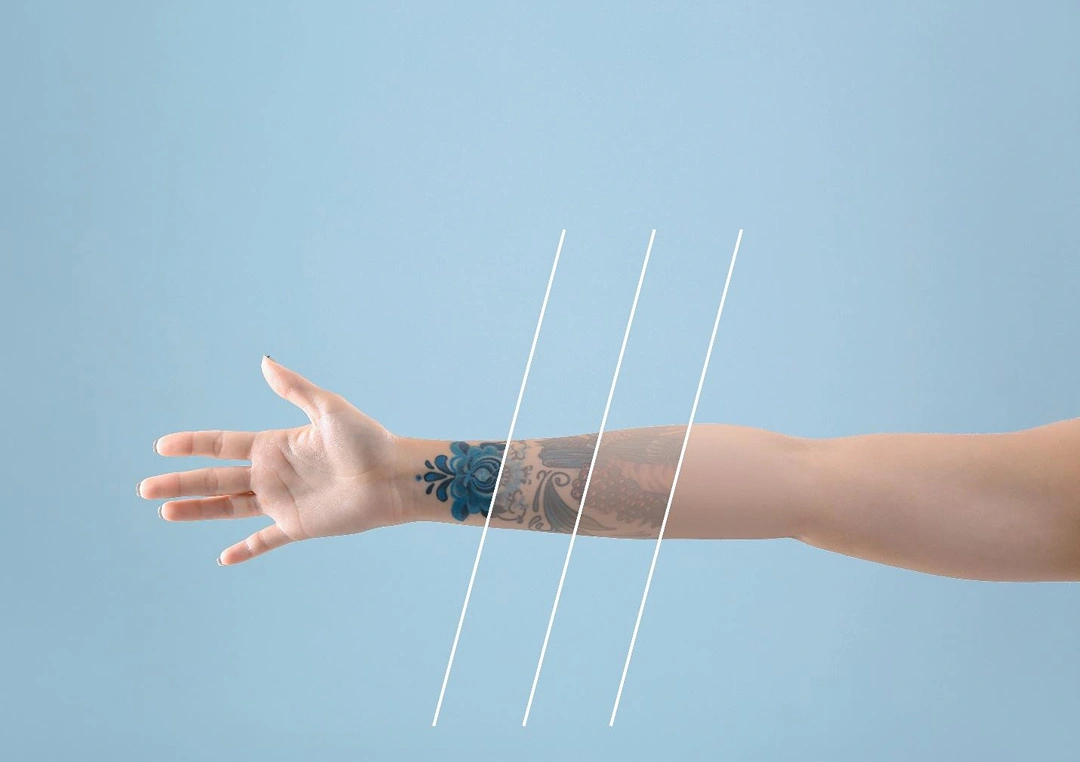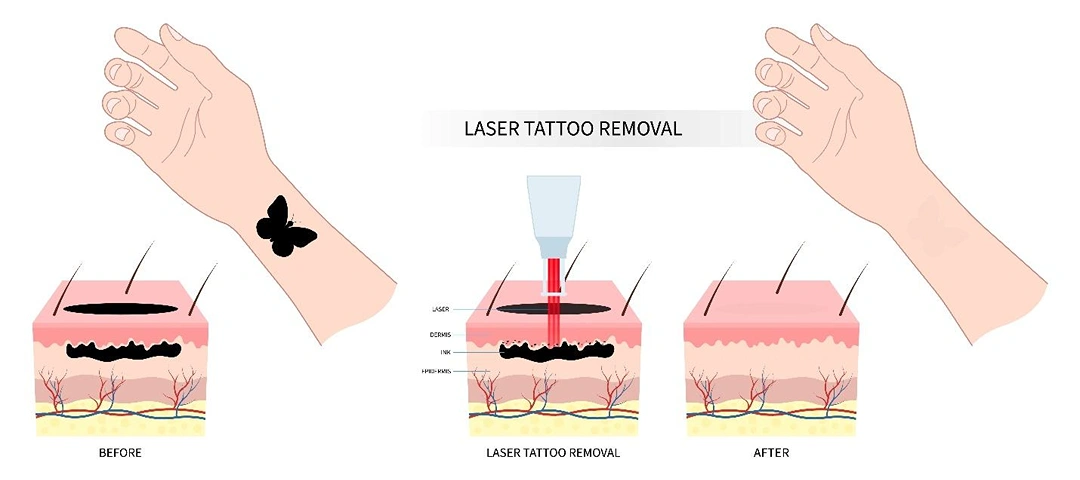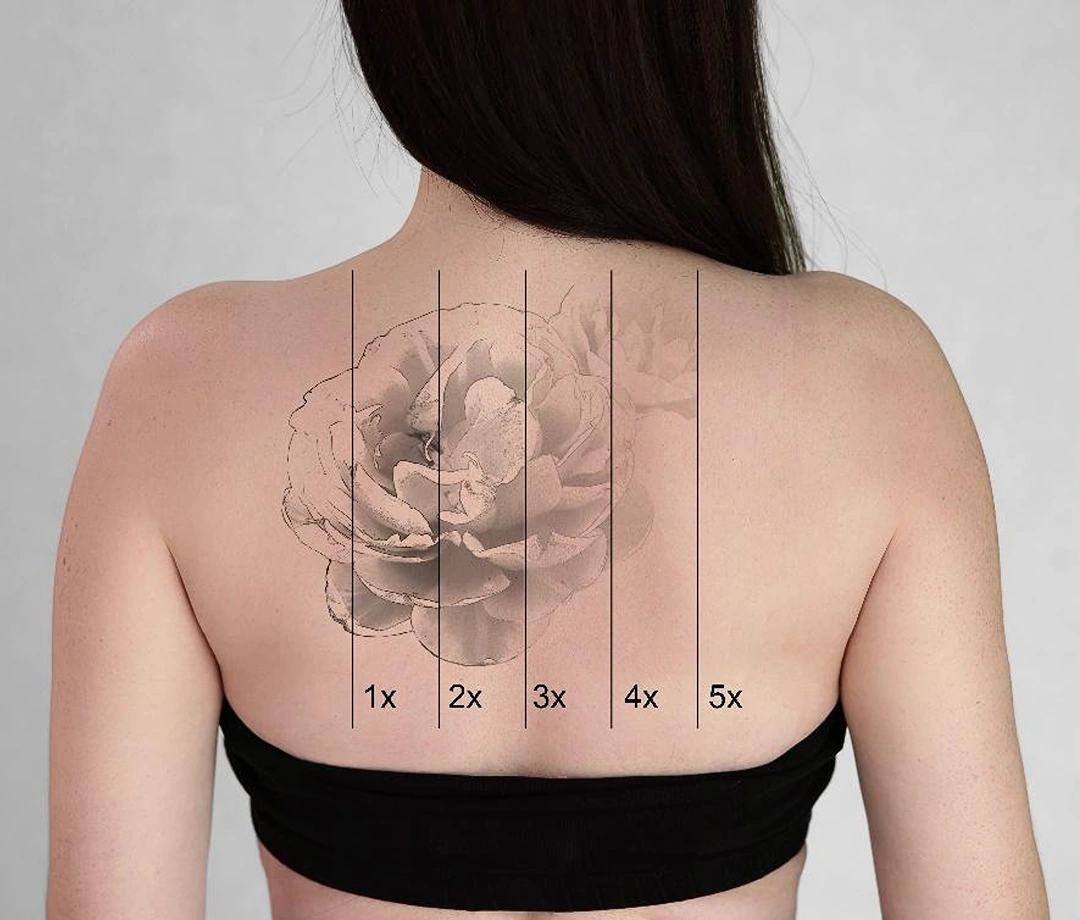At Livingstone Dermatology, we understand that your skin is a reflection of your health and well-being. We are committed to the latest advancements in dermatological science, and dedicated to providing you with quality care.

Tattoos can be deeply personal, but so can the decision to remove them. Whether it is a change in aesthetic, lifestyle, or circumstances, laser tattoo removal offers a safe and effective way to fade or erase unwanted ink.
Using modern laser technology, including pico lasers, tattoo removal treatments break down ink particles beneath the skin, allowing the body’s immune system to gradually clear them away. The process is precise, customisable, and suitable for various skin types and tattoo styles, from amateur ink to cosmetic enhancements.

Tattoo ink is embedded deep within the skin’s dermal layer, making it difficult to remove through surface treatments alone. Laser removal works by delivering
high-intensity light pulses
that specifically target pigment particles. These pulses are absorbed by the ink and cause the pigment to shatter into smaller fragments, which are then naturally eliminated by the body’s immune and lymphatic systems over time.
Pico lasers operate at incredibly short pulse durations that are measured in picoseconds. This allows for greater precision and pigment clearance with less heat, reducing the risk of skin damage, especially in darker skin tones.
Treatment parameters, such as wavelength, energy level (fluence), and spot size, are tailored to your tattoo’s characteristics, including:

Laser tattoo removal is not a one-off procedure but a carefully planned journey that balances precision with skin safety. Each step, from consultation to post-treatment care, is tailored to your tattoo’s specific characteristics and your skin’s unique needs.
Generally, here is what you can expect throughout the process:
Before the procedure
Your treatment journey begins with a detailed consultation. Our dermatologist will assess your tattoo’s characteristics. This includes age, size, colour, location, and ink depth. Our dermatologists will also evaluate your skin type. Based on this, a tailored treatment plan will then be created.
Before the procedure, our dermatologist will also advise on any pre-treatment care, such as avoiding sun exposure or certain skincare products.
During the procedure
To keep discomfort to a minimum, topical or local anaesthesia will be applied. Protective eyewear will be provided, and the laser device will be used to deliver ultra-short pulses of light to the tattooed area. Most sessions last between 15 to 45 minutes, depending on tattoo complexity.
You may feel a warm, snapping sensation as the laser pulses hit the skin that is often likened to the snap of an elastic band.
After the procedure
The treated area may appear red, swollen, or feel sensitive, similar to mild sunburn. Blistering or bruising is common in the short term and usually resolves within a few days. A dressing may be applied, and you will receive specific post-treatment instructions to optimise healing and reduce scarring risk.
Multiple sessions, spaced 6 to 8 weeks apart, are typically required for optimal results. During the post-procedure follow-up sessions, our dermatologist will monitor your skin’s response and adjust your plan as needed.
While generally well-tolerated, tattoo removal carries certain risks:

Laser tattoo removal may not be suitable if you have:
Tattoo removal is rarely immediate. While some fading can be seen after just one session, full clearance, especially for multi-coloured or older tattoos, may take several treatments.
Even so, most patients experience:
However, full removal depends on many factors, including ink type, depth, and your body’s immune response. In some cases, faint remnants may remain, especially with stubborn colours like green or yellow.
Even partial fading can significantly reduce the tattoo’s appearance, allowing for either full removal or effective cover-up if desired. As such, having your treatment performed by an experienced dermatologist ensures risks are minimised and outcomes are safely managed.
As tattoo removal is a gradual process, the number of sessions required varies from person to person. Several factors influence how quickly your tattoo fades:
On average, most patients require 6 to 10 sessions, spaced about 6 to 8 weeks apart, to achieve optimal clearance. Some may see dramatic fading after just a few treatments, while others, particularly with multi-coloured or resistant inks, may need a more extended course.

At Livingstone Dermatology, we recognise that choosing to remove a tattoo is a personal decision. It is often shaped by changes in lifestyle, identity, or circumstance. Whether you are looking to fully erase a design or simply lighten it for a cover-up, our experienced dermatologists are here to support you every step of the way, with expert care and judgment-free understanding.
Book a consultation with us today to learn more about your options and take the first step towards clearer, more confident skin.
Does tattoo removal hurt?
Most people describe the sensation as similar to an elastic band snapping against the skin. While it can be uncomfortable, topical or local anaesthesia is provided to minimise pain. The discomfort is usually short-lived and fades soon after each session.
Can I remove tattoos on any part of the body?
Yes, tattoos can be removed from nearly all areas of the body. However, some regions (such as the ankles or fingers) may take longer to heal due to lower circulation and may require more sessions.
Can tattoos be completely removed?
Yes, complete removal is possible for many tattoos. But the results vary based on ink colour, density, skin type, and your body’s ability to clear pigment. Our dermatologist will advise what’s realistic for your specific case.
Can I remove part of a tattoo or just lighten it for a cover-up?
Yes. Laser tattoo removal can be used to fade specific parts of a tattoo or lighten the overall design. This is often done to prepare for a new tattoo or improve the results of a cover-up. Our dermatologist will tailor the treatment to your desired outcome.
Will tattoo removal leave a scar?
Scarring is rare when performed correctly and with proper aftercare. Following our dermatologist’s instructions is key to reducing this risk.
Will laser tattoo removal damage the surrounding skin?
Modern laser technology targets only the pigment in the tattoo, leaving surrounding tissue largely unaffected. When performed by a trained dermatologist using the correct settings, the risk of damage is very low.
Is laser tattoo removal safe for dark skin?
Yes, but extra caution is required. Longer wavelengths, lower fluences, and larger spot sizes help reduce the risk of pigmentation changes. Always seek treatment from professionals experienced in treating ethnic skin.
Can I undergo tattoo removal if I have sensitive skin?
Yes, but extra precautions are taken. If you have sensitive skin or a history of skin reactions, our dermatologist may perform a small test patch before proceeding with full treatment. Settings can also be adjusted to suit your skin’s needs.
Can I remove cosmetics or medical tattoos?
Yes. Cosmetic tattoos (like eyeliner or lip liner) and medical tattoos (used for marking or camouflage) can be treated, though they may respond differently due to ink composition.
What should I avoid after each session?
To promote healing, avoid sun exposure, hot baths, intense workouts, or applying harsh products to the treated area for several days. Our dermatologist will give you detailed aftercare instructions to follow between sessions.
Can I get a new tattoo after removal?
Yes. Once the skin has fully healed, you can safely have a new tattoo placed over the treated area. Many people opt for removal to create space for a new design or to improve the look of a cover-up tattoo.
Can I remove a cyst at home?
No, it is not recommended to pop or squeeze a cyst yourself. This can lead to infection, inflammation, or scarring. Incomplete removal of the cyst wall can also cause it to recur. It is best to have cysts properly assessed and treated by a dermatologist.
Can I drain an abscess at home?
You can apply a warm compress to help relieve discomfort, but abscesses should be drained by a healthcare provider. Attempting to pop or drain an abscess on your own increases the risk of spreading the infection deeper into the tissues, incomplete drainage and scarring.
Will an abscess go away on its own?
Some small abscesses may drain and heal without treatment. However, if the abscess persists for more than 1 to 2 weeks, becomes more painful, or the size increases, seek medical attention. Delaying treatment may lead to complications.
Will cysts and abscesses leave scars?
Scarring can occur, especially if the lesion was inflamed, infected, or surgically removed. Scars may appear as flat marks, dark spots (post-inflammatory hyperpigmentation), or pitted areas similar to acne scars. Scar severity often depends on the size and location of the lesion, skin type and the treatment method used.
Are cysts contagious?
No, cysts are not contagious. They are usually caused by blocked follicles or trapped keratin under the skin, not by infection. However, if a cyst becomes infected, the bacteria may be spread through contact with the pus.
Are abscesses contagious?
Yes, abscesses caused by bacterial infections can be contagious, especially if the pus comes into contact with broken skin. Proper hygiene and wound care are important to prevent spreading the infection to others.
When should I see a doctor for a cyst or abscess?
You should consult a dermatologist if:
Whether you’re dealing with a specific skin concern or seeking to enhance your natural beauty, Livingstone Dermatology is here to guide you on your journey to healthy, radiant skin.
Schedule an appointment today and experience the Livingstone standard of care in a welcoming, professional environment.